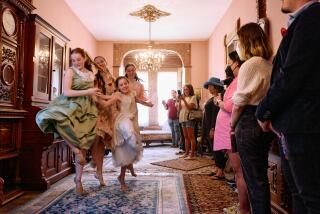Lee Group’s Bodies in Motion Blend Artfully at Getty Center
- Share via
There is always a line of people waiting to get into the “Friday Nights at the Getty” dance series, which now runs every weekend until May 19. It could be because it’s free, but sometimes you can’t give modern dance away, so specialized is its audience. Museum-goers, however, might be ready for bodies that move after the splendors of fairly static art and architecture.
On Friday, Hae Kyung Lee and Dancers were a good match for the Getty, since they featured majestic lines and sculptural depth. In three works that together lasted just an hour, Lee’s buff and well-tempered dancers seemed primed to be looked at and adored. Mostly, the works offered a good return for your gaze.
In “No Room to Move” (1995), all seven dancers, in various frocks (even the two men), grimaced and posed languorously in white metal chairs, as if for a magazine photographer. They seemed quirky and troubled as they built to flinging and diving movements, never straying far from their chairs and eventually returning to their initial positions.
“Blank Slate” (1999) relied on strategically sculpted near-stillness as well, this time framing tiny tableaux and two stunning solos in squares of soft white light. The incredibly watchable Kishisa Ross merged the introspective concentration of tai chi with the self-conscious posing of a starlet in a bubble bath. The combination was fascinating.
Miguel Olvera also combined meditative moving with a film image--he could have been a gangster having an identity crisis, with his stylish dives to the ground and inverted poses, both of which are seen throughout Lee’s work. A short concluding duet of lifting and spinning went too far toward cliche at the end.
The dynamics of both these pieces were enhanced by taped scores from Steve Moshier, who appeared for the premiere of “Rear Windows,” along with the Liquid Skin Ensemble. Moshier often builds minimalist tension with a melody of about four notes, taking its variations into seductively intense territory. But the movement motifs of this last piece--spinning, gently waving extensions and sudden drops--weren’t as compelling as the music.
More to Read
The biggest entertainment stories
Get our big stories about Hollywood, film, television, music, arts, culture and more right in your inbox as soon as they publish.
You may occasionally receive promotional content from the Los Angeles Times.










